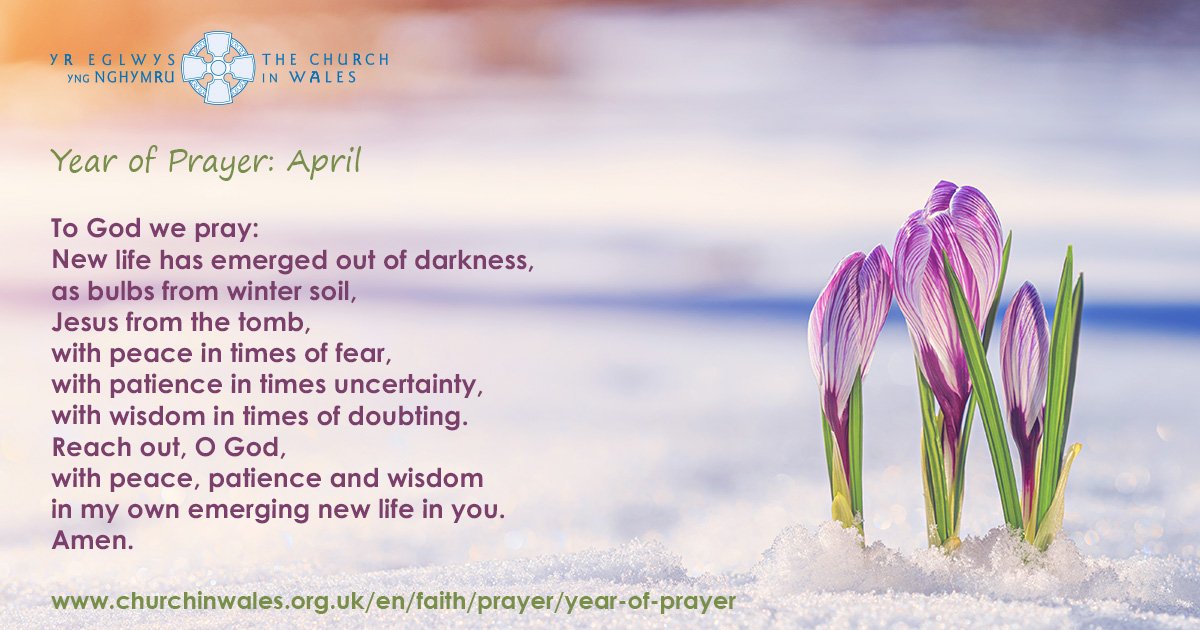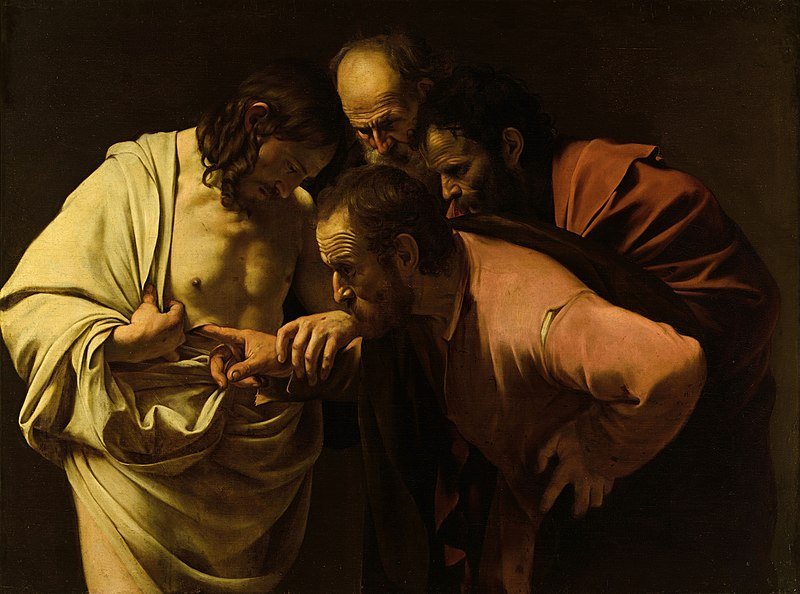April 2023 - New Life, Easter, Discipleship
Welcome to the April Prayer, and the eighth in our series of 12. Each month we will explore different themes and different ways of praying which we hope you will find helpful as ways in which to encounter God.
The Provincial Spirituality Group in the Church in Wales.
Introduction
During the Easter season, our hearts turn to the promise of new life in Christ and the joy of the resurrection. Jesus invites each one of us to come; to follow him, even in our doubt and uncertainty. The prayer for this month is:
imaginative contemplation
It’s a way of prayer where you imagine yourself present in a Gospel scene, stepping into the story and encountering Jesus there. It can help us to see more clearly, love more dearly, and follow more nearly the person of Jesus Christ.

Bible Passage
John 20. 24-29
The reading is taken from the gospel of John and tells us of the second appearance of Jesus after the resurrection.
But Thomas (who was called the Twin), one of the twelve, was not with them when Jesus came. So the other disciples told him, ‘We have seen the Lord.’ But he said to them, ‘Unless I see the mark of the nails in his hands, and put my finger in the mark of the nails and my hand in his side, I will not believe.’
A week later his disciples were again in the house, and Thomas was with them. Although the doors were shut, Jesus came and stood among them and said, ‘Peace be with you.’ Then he said to Thomas, ‘Put your finger here and see my hands. Reach out your hand and put it in my side. Do not doubt but believe.’ Thomas answered him, ‘My Lord and my God!’ Jesus said to him, ‘Have you believed because you have seen me? Blessed are those who have not seen and yet have come to believe.’
Reflection
As Jesus greeted his own anxious disciples with the words ‘Peace be with you!’, we, like ‘Doubting Thomas’, can respond in awe and wonder, ‘My Lord and my God’. Thomas - ‘Doubting Thomas’ as he’s often called – wasn’t with the other disciples when Jesus first came to the disciples after the resurrection, and whatever they might have told him, he struggled to believe. To help him believe, he wants to touch and see the mark of the nails.
Alfred, Lord Tennyson (1809-92), In Memoriam, XCV wrote ‘There lives more faith in honest doubt, Believe me, than in half the creeds.’ Thomas is the disciple who had shared his life with Jesus, yet still found it difficult to accept all he had heard. He can speak for all of us too, who haven’t seen the physical person of Jesus, but have come to believe. Doubting can be healthy and deepen our faith when we seek to understand by asking the questions we struggle with.
What are the questions you would ask to help deepen your understanding of what it means to be a follower and disciple of Jesus?
When Thomas finally encounters Jesus, he is able to say those wonderful words of belief ‘My Lord and my God’. This very realistic story takes us into the heart of what it means to be a Christian: how God can transform even our doubts to bring us peace and new life in the resurrection of Christ.
As we pray this month, in imaginative contemplation, it is to seek the courage to be faithful disciples, trusting that God will open our hearts to recognise the risen Christ present amongst us.
Main Prayer (Imaginative Contemplation)
Imaginative prayer is one of the hallmarks of Ignatian Spirituality: St Ignatius believed that God can speak to us just as clearly in our imagination as through our thoughts.
Don’t worry if this way of praying seems a little alien at first. God can speak to us in many different ways – through the scriptures and the sacraments, through our daily experiences and emotions. Our imagination is also a wonderful God-given gift, which can help us develop a unique and personal relationship with the Jesus of the Gospels.
As you start your prayer, take a moment to become quiet and still. Be aware that you are in God’s presence, and ask the Holy Spirit to guide you. Then read the Gospel passage – printed above - through slowly, perhaps a couple of times, and look at the three images at the end if it helps.
Then close your eyes, and allow God to use your imagination to help you experience the scene as if you’re right there. You don’t need to worry about historically accurate details, or if the scene develops differently from the passage itself. Just trust that the Holy Spirit will let you see what God wants to show you.
Take a moment to imagine the disciples gathered in the upper room at the beginning of this scene, and allow yourself to join them – perhaps as a disciple; as Thomas; or simply as an onlooker. Then take time to allow all your senses to come into play.
Look round the room itself, with its locked doors. Is it low-ceilinged, maybe dark and stuffy, or is it light and airy? Notice the expression on your companions’ faces, including Thomas … perhaps you see grief, or scepticism, or fear, or excitement …? What can you hear … both within and outside the room? What can you smell … perhaps stale air … or a warm breeze coming in through a window? What are you wearing, and how do your clothes feel? Notice the mood of the gathering … how you yourself are feeling.
Watch Jesus as he arrives in the room. How does he look, and sound as he speaks to Thomas? Watch him as he invites him to touch his wounds. Don’t worry if you can’t see his face; just try to sense his presence, his closeness.
Now allow Jesus turn to you and greet you, perhaps with the words he speaks to Thomas: (‘[Your name], peace be with you). How do you want to respond? Perhaps you reach out to touch Jesus yourself, or he extends a hand to you. Allow a conversation to develop … or if you prefer simply remain together in reverent silence.
Talk to Jesus or to God for a moment about how you feel, as you’d talk naturally to a friend.
When you’re ready, slowly take your leave of the scene, and close your prayer with Thomas’s own declaration of faith: ‘My Lord and my God!’ or with words of your own choice.
Later, make a few notes on how your prayer went, perhaps over a cup of tea. What happened in the story? Were there any insights, emotions, memories and feelings? This will help you reflect on your experience and what God may have been showing you.
Suggestions for Prayer
Prayer of St Richard of Chichester (modernised version, text in public domain)
O dear Lord,
Three things I pray,
To see you more clearly,
love you more dearly,
and follow you more nearly,
day by day.
Amen.
Collect for the feast of St Thomas the Apostle (3 July)
Almighty and eternal God,
who, for the firmer foundation of our faith,
allowed your holy apostle Saint Thomas
to doubt the resurrection of your Son
till word and sight convinced him:
grant to us, who have not seen,
that we may also believe
and so confess Christ as our Lord and our God;
who is alive and reigns with you and the Holy Spirit,
one God, now and for ever.
Amen.
A Sonnet for St Thomas the Apostle by Malcolm Guite
by kind permission of Malcolm Guite
Art

Attribution: Caravaggio, Public domain, via Wikimedia Commons

Attribution: JESUS MAFA. Jesus appears to Thomas, from Art in the Christian Tradition, a project of the Vanderbilt Divinity Library, Nashville, TN.
Music
My Peace I Leave You; My Peace I Give You; Trouble Not Your Heart My Peace I Leave You; My Peace I Give You; Be Not Afraid
Books
Rowan Williams, Being Disciples: Essentials of the Christian life (London: SPCK, 2019: ISBN: 9780281076628)
David L. Fleming SJ, What is Ignatian Spirituality? (Loyola Press, 2008). Includes a very short chapter on ‘Pray with your Imagination’
James Martin SJ, Learning to Pray: A Guide for Everyone (Harper Collins, 2021): especially ch 12, ‘The Gift of Imagination’
Kate McIllhagga, ‘Thomas’ - Dawn’s Ribbon of Glory: Prayers and poems for Easter and beyond: Iona Books
Next Month
We hope that you have found these reflections and prayers helpful, and they may of course need thinking about and praying more than once. Next month our theme and prayers will be to look celebration and discernment.